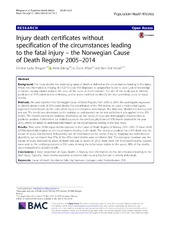| dc.contributor.author | Ellingsen, Christian Lycke | en_US |
| dc.contributor.author | Ebbing, Marta | en_US |
| dc.contributor.author | Alfsen, G. Cecilie | en_US |
| dc.contributor.author | Vollset, Stein Emil | en_US |
| dc.date.accessioned | 2019-05-27T11:40:34Z | |
| dc.date.available | 2019-05-27T11:40:34Z | |
| dc.date.issued | 2018-12-24 | |
| dc.Published | Ellingsen CL, Ebbing M, Alfsen GC, Vollset SE. Injury death certificates without specification of the circumstances leading to the fatal injury - the Norwegian Cause of Death Registry 2005-2014. Population Health Metrics. 2018;16:20 | eng |
| dc.identifier.issn | 1478-7954 | |
| dc.identifier.uri | https://hdl.handle.net/1956/19723 | |
| dc.description.abstract | Background: For injury deaths, the underlying cause of death is defined as the circumstances leading to the injury. When this information is missing, the ICD-10 code X59 (Exposure to unspecified factor) is used. Lack of knowledge of factors causing injuries reduces the value of the cause of death statistics. The aim of this study was to identify predictors of X59-coded deaths in Norway, and to assess methods to identify the true underlying cause of injury deaths. Methods: We used data from the Norwegian Cause of Death Registry from 2005 to 2014. We used logistic regression to identify determinants of X59-coded deaths. For redistribution of the X59 deaths, we used a multinomial logistic regression model based on the cases where injury circumstances were known. The data were divided into training and test sets. The model was developed on the training set and assessed on the test set before it was applied to the X59 deaths. The models used death certificate information on the nature of injury and demographic characteristics as predictor variables. Furthermore, we mailed a query to the certifying physicians of X59 deaths reported in the year 2015, where we asked for additional information on the circumstances leading to the fatal injury. Results: There were 24,963 injury deaths reported to the Cause of Death Registry of Norway 2005–2014. Of these, 6440 (25.8%) lacked information on the circumstances leading to the death. The strongest predictor for a X59 death was the nature of injury (hip fracture), followed by lack of information on the scene of injury. Applying our redistribution algorithm, we estimated that 97% of the X59-coded deaths were accidental falls. The strongest covariate was the nature of injury, followed by place of death and age at death. In 2015, there were 591 X59-coded deaths. Queries were sent to the certifying doctors in 559 cases. Among the informative replies to the query, 88% of the deaths were reclassified to accidental falls. Conclusions: A large proportion of injury deaths in Norway lack information on the circumstances leading to the fatal injury. Typically, these deaths represent accidental falls causing hip fracture in elderly individuals. | en_US |
| dc.language.iso | eng | eng |
| dc.publisher | BioMed Central | eng |
| dc.relation.uri | https://www.ncbi.nlm.nih.gov/pmc/articles/PMC6304779/pdf/12963_2018_Article_176.pdf | |
| dc.rights | Attribution CC BY | eng |
| dc.rights.uri | http://creativecommons.org/licenses/by/4.0 | eng |
| dc.subject | Cause of death | eng |
| dc.subject | Accidental falls | eng |
| dc.subject | Hip fractures | eng |
| dc.subject | Garbage code | eng |
| dc.subject | Redistribution | eng |
| dc.subject | X59 | eng |
| dc.title | Injury death certificates without specification of the circumstances leading to the fatal injury - the Norwegian Cause of Death Registry 2005-2014 | en_US |
| dc.type | Peer reviewed | |
| dc.type | Journal article | |
| dc.date.updated | 2019-01-10T12:47:31Z | |
| dc.description.version | publishedVersion | en_US |
| dc.rights.holder | Copyright 2018 The Author(s) | |
| dc.identifier.doi | https://doi.org/10.1186/s12963-018-0176-2 | |
| dc.identifier.cristin | 1654170 | |
| dc.source.journal | Population Health Metrics | |

